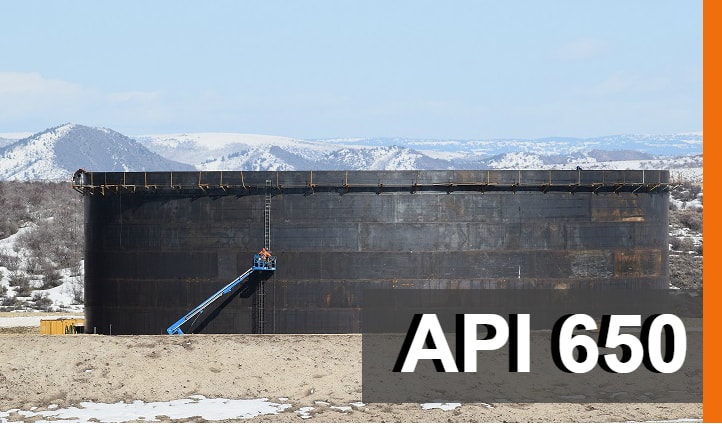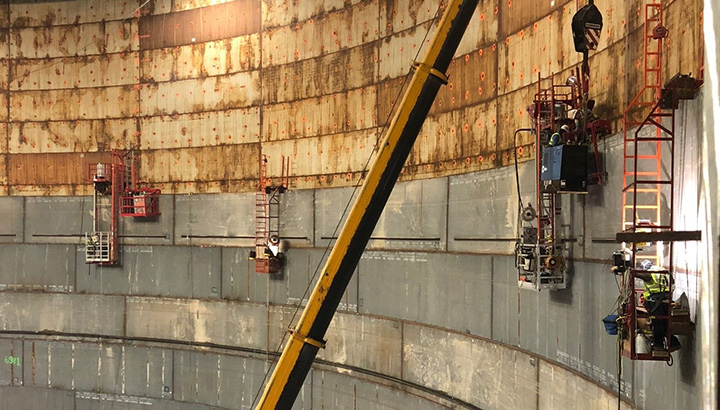API 650 Welding Inspection: Reliable Steps for Maintaining Safety Standards
A Step-by-Step Consider the Installation Refine of Welding Examination Techniques
Welding evaluation is an essential procedure that guarantees architectural stability and safety and security. The installation of examination techniques involves numerous organized actions, each indispensable to attaining dependable results. From preparation and device selection to conducting visual and non-destructive tests, each phase needs cautious interest. Comprehending these treatments can substantially boost top quality guarantee in welding jobs. What difficulties emerge in carrying out these techniques, and exactly how can they be properly attended to?
Recognizing the Relevance of Welding Assessment
Welding inspection is a crucial part of making certain structural honesty and security in building and manufacturing procedures. This technique entails reviewing bonded joints for issues, guaranteeing that they meet particular requirements and guidelines. By methodically assessing weld quality, examiners can determine concerns such as splits, gaps, and incomplete blend, which can endanger the strength and longevity of frameworks.
The relevance of welding evaluation prolongs past prompt security problems; it assists stop pricey failures and potential hazards in the long-term. Effective examination methods foster compliance with industry requirements, thereby improving the overall dependability of welded components. Furthermore, a durable assessment process adds to keeping the track record of builders and manufacturers, as it ensures customers of the top quality of their projects. Eventually, understanding the value of welding examination is vital for advertising risk-free building techniques and making sure the longevity of important infrastructure and products.
Picking the Right Devices for Evaluation
When choosing the suitable tools for assessment, it is necessary to contemplate the particular requirements of the welding procedure and the materials entailed. Different assessment techniques, such as visual, ultrasonic, and radiographic screening, necessitate distinctive devices customized to their special needs. For visual evaluations, tools like amplifying glasses and calipers are important for evaluating weld top quality. Ultrasonic testing requires specific equipment qualified of transmitting and receiving acoustic waves to identify inner problems. Radiographic screening, on the various other hand, utilizes X-ray or gamma-ray sources together with sensitive movie or electronic detectors to disclose inconsistencies.
Additionally, personal safety devices (PPE) is vital to guarantee the safety of assessors throughout evaluations. Picking the right devices not only boosts the accuracy of examinations yet also contributes to the total stability and safety of the welding task. A detailed understanding of available devices and their applications is important for reliable welding assessment.
Preparing for the Assessment Refine
Before launching the inspection procedure, it is vital to establish an extensive strategy that details the extent and goals of the assessment. This plan must consist of particular standards that define what makes up appropriate high quality in the welding work being checked. Recognizing the appropriate codes and criteria is crucial, as they will assist the assessment criteria and methods.
Furthermore, workers included in the examination has to be adequately trained and accredited in welding inspection methods to assure dependability and precision. A list can be beneficial in organizing the different aspects of the inspection, varying from devices readiness to ecological conditions that can affect the evaluation.

Ultimately, logistical considerations such as organizing, available sources, and communication between team members ought to be dealt with. By preparing methodically, inspectors can enhance the efficiency of the examination and make sure that all important aspects are duly considered prior to proceeding with the inspection itself.
Carrying Out Visual Inspections

Conducting visual examinations is a necessary action in the welding assessment procedure, needing careful preparation to guarantee effective assessment. Inspectors have to be acquainted with essential flaw signs that can signal possible issues in weld high quality. By concentrating on these aspects, one can enhance the overall integrity of the examination end results.
Getting Ready For Visual Evaluation
Aesthetic inspection works as a vital very first step in the welding examination process, guaranteeing that any kind of prospective issues are determined early (API 650 Welding Inspection). Appropriate prep work is essential for effective visual examination. Examiners ought to begin by examining relevant paperwork, consisting of welding treatments and specs, to comprehend the project demands. They need to gather needed devices, such as multiplying glasses, flashlights, and suitable individual safety tools (PPE) A detailed assessment of the examination area is vital; examiners should verify it is cost-free informative post and clean of obstructions. In addition, it is essential to establish ideal illumination problems to enhance exposure of welds. By taking these primary steps, assessors can create an atmosphere conducive to identifying inconsistencies and ensuring the integrity of the bonded frameworks
Secret Defect Indicators
An extensive understanding of why not try these out essential flaw indications is vital during visual assessments to assure the top quality and safety of welded joints. Examiners should concentrate on details indications such as cracks, porosity, damages, and incomplete fusion. Splits might look like sharp lines and can compromise structural stability. Porosity materializes as little holes that can compromise weld stamina. Undercuts, which are grooves along the weld side, can bring about tension focus. Insufficient combination suggests that the weld metal did not correctly bond with the base material, causing a weak joint. By systematically recognizing these flaws, inspectors can establish compliance with industry requirements and boost the total integrity of bonded structures, ultimately adding to more secure functional conditions.
Implementing Non-Destructive Examining Strategies

Various non-destructive screening (NDT) methods are integral to ensuring the integrity of welded structures without endangering their performance. These approaches permit examiners to review weld quality and discover issues without causing damages to the products being examined. Common NDT techniques include ultrasonic screening, radiographic screening, magnetic bit screening, and color penetrant testing. Each method offers a particular purpose, resolving different kinds of flaws such as splits, porosity, or incomplete fusion.
Carrying out NDT strategies calls for a methodical strategy, beginning with picking the suitable approach based on the materials and the nature of the weld. Educating employees in these methods is necessary for exact results. Furthermore, developing clear procedures and standards guarantees consistency throughout the examination procedure. By incorporating NDT into the welding assessment workflow, organizations can enhance the integrity of their products while reducing potential dangers connected with structural failings. This positive approach inevitably adds to preserving safety and security and quality requirements in bonded buildings.
Recording and Analyzing Examination Outcomes
Reliable documentation and analysis of evaluation outcomes are important elements of the welding evaluation process. Precise records of inspection searchings for act as a recommendation for quality control and compliance with sector requirements. API 650 Welding Inspection. Assessors Find Out More should utilize structured forms or electronic platforms to log information such as the kind of weld, evaluation approaches used, and any discrepancies recognized throughout the assessment
Complete analysis is vital as soon as data is collected. This entails comparing outcomes versus developed criteria to determine fads or repeating concerns. Statistical tools may be used to measure defects and evaluate their effect on general weld quality.
Moreover, reliable communication of searchings for to relevant stakeholders is critical. Summaries and records should be clear and concise, highlighting vital understandings and recommendations for restorative activities. By methodically recording and examining evaluation outcomes, companies can cultivate continuous improvement in welding techniques and enhance product integrity.
Regularly Asked Concerns
What Certifications Are Required to Become a Welding Assessor?
To end up being a welding inspector, one generally requires appropriate accreditations such as AWS CWI, together with experience in welding techniques, expertise of welding codes, and proficiency in examination strategies to assure high quality and safety requirements.
Just How Typically Should Welding Inspections Be Carried Out?
Welding assessments should be conducted routinely, typically after each weld is completed, and periodically during jobs. Factors such as job intricacy, market standards, and regulative demands can influence the regularity of these examinations.
What Is the Price of Welding Evaluation Services?
The expense of welding evaluation services differs considerably based upon variables such as project size, complexity, and area. Typically, costs range from $100 to $150 per hour, with added fees for specialized testing and qualifications.
Are There Certifications for Welding Inspectors?
Yes, there are numerous qualifications for welding inspectors, consisting of those offered by the American Welding Culture (AWS) and the International Institute of Welding (IIW) These accreditations ensure assessors have the necessary abilities and expertise for efficient examinations.

Just how Do I Pick an Inspection Company?
To select an evaluation provider, one need to assess certifications, experience, market track record, and client testimonials. In addition, comparing solution offerings and prices can aid assure the selected company fulfills certain project requires effectively.
Additionally, personnel entailed in the assessment should be sufficiently trained and licensed in welding examination methods to ensure dependability and accuracy. Conducting visual inspections is an important step in the welding evaluation process, requiring cautious prep work to ensure reliable assessment. Aesthetic assessment offers as an important initial action in the welding examination procedure, assuring that any kind of prospective defects are identified early. Efficient documentation and analysis of assessment results are vital elements of the welding evaluation procedure. Welding assessments must be performed regularly, normally after each weld is completed, and regularly throughout jobs.